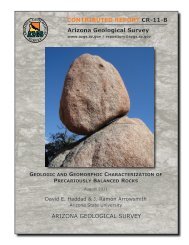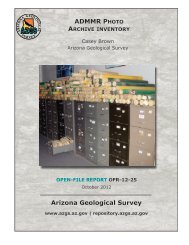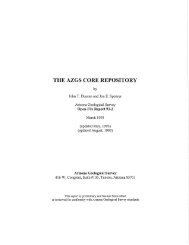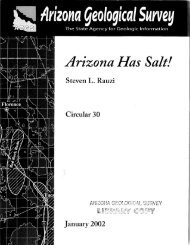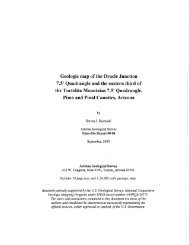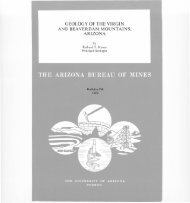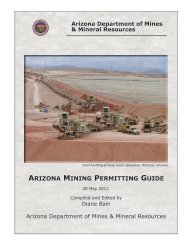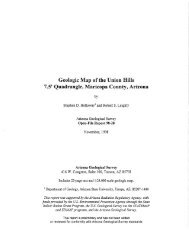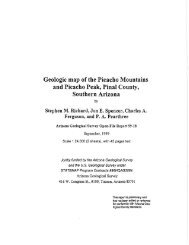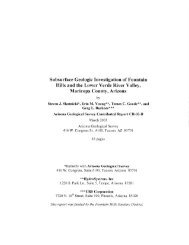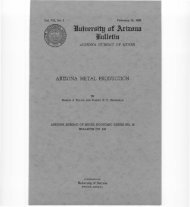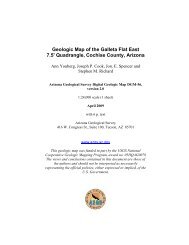the geology and producnon history of uranium deposits in the salt
the geology and producnon history of uranium deposits in the salt
the geology and producnon history of uranium deposits in the salt
You also want an ePaper? Increase the reach of your titles
YUMPU automatically turns print PDFs into web optimized ePapers that Google loves.
THE GEOLOGY AND PRODUCTION HISTORY<br />
OF URANIUM DEPOSITS IN THE SALT WASH MEMBER<br />
OF THE MORRISON FORMATION, NEAR ROUGH,ROCK<br />
APACHE COUNTY, ARIZONA<br />
INTRODUCTION<br />
The Salt Wash Member <strong>of</strong> <strong>the</strong> Morrison Formation <strong>of</strong> Jurassic age conta<strong>in</strong>s<br />
significant <strong>deposits</strong> <strong>of</strong> <strong>uranium</strong>-vanadium m<strong>in</strong>erals <strong>in</strong> <strong>the</strong> Lukachukai Mounta<strong>in</strong>s<br />
<strong>in</strong> nor<strong>the</strong>astern Apache County, Arizona. Similar, but smaller, <strong>deposits</strong> have<br />
been m<strong>in</strong>ed around <strong>the</strong> perimeter <strong>of</strong> <strong>the</strong> Carrizo Mounta<strong>in</strong>s north <strong>of</strong> <strong>the</strong> Lukachukai<br />
Mounta<strong>in</strong>s (Chenoweth <strong>and</strong> Malan, 1973).<br />
Dur<strong>in</strong>g <strong>the</strong> <strong>uranium</strong> boom <strong>of</strong> <strong>the</strong> 1950's a small amount <strong>of</strong> <strong>uranium</strong> was m<strong>in</strong>ed<br />
from <strong>the</strong> Salt Wash near Rough Rock Trad<strong>in</strong>g Post <strong>in</strong> northwestern Apache<br />
County (Figure 1). Although some <strong>in</strong>formation concern<strong>in</strong>g this area has been<br />
published (Chenoweth <strong>and</strong> Malan, 1973), this report gives <strong>the</strong> details <strong>of</strong> <strong>the</strong><br />
production <strong>history</strong>.<br />
Much <strong>of</strong> <strong>the</strong> <strong>in</strong>formation presented here was recently located <strong>in</strong> <strong>the</strong> old<br />
records <strong>of</strong> <strong>the</strong> U.S. Atomic Energy Commission (AEC) <strong>in</strong> <strong>the</strong> archives <strong>of</strong> <strong>the</strong><br />
U.S. Department <strong>of</strong> Energy's Gr<strong>and</strong> Junction Projects Office, Gr<strong>and</strong> Junction,<br />
Colorado. A review <strong>of</strong> <strong>the</strong> 1950-53 records <strong>of</strong> <strong>the</strong> AEC's ore-buy<strong>in</strong>g stations<br />
provided accurate <strong>in</strong>formation on <strong>the</strong> dates early ore shipments were received.<br />
Information previously published by Chenoweth <strong>and</strong> Malan (1973) <strong>and</strong> Chenoweth<br />
(1973) was found to be <strong>in</strong>correct.<br />
GEOLOGIC SETTING<br />
The Salt Wash Member <strong>of</strong> <strong>the</strong> Morrison Formation caps benches at <strong>the</strong><br />
nor<strong>the</strong>astern foot <strong>of</strong> Black Mesa (Figure 1). On <strong>the</strong> east side <strong>of</strong> Black Mesa <strong>the</strong><br />
member is absent by non-deposition. The Salt Wash Member <strong>in</strong> <strong>the</strong> Rough<br />
Rock area consists <strong>of</strong> approximately 130 feet <strong>of</strong> <strong>in</strong>terbedded f<strong>in</strong>e- to very f<strong>in</strong>egra<strong>in</strong>ed<br />
grayish-brown s<strong>and</strong>stone <strong>and</strong> graY,green, <strong>and</strong> reddish-brown siltstone<br />
<strong>and</strong> mudstone. Secondary <strong>uranium</strong> m<strong>in</strong>erals are associated with carbonaceous<br />
fossil logs <strong>and</strong> o<strong>the</strong>r plant debris <strong>in</strong> s<strong>and</strong>stone lenses 10 to 40 feet above <strong>the</strong><br />
base <strong>of</strong> <strong>the</strong> Salt Wash Member. Fossil logs, observed dur<strong>in</strong>g m<strong>in</strong><strong>in</strong>g operations,<br />
have been at least 14 <strong>in</strong>ches <strong>in</strong> diameter <strong>and</strong> over 10 feet <strong>in</strong> length. Calcite<br />
crystals associated with <strong>the</strong> logs were responsible for <strong>the</strong> ore shipments to<br />
average 31% CaC03' Non-vanadiferous primary <strong>uranium</strong> m<strong>in</strong>erals, such as uran<strong>in</strong>ite<br />
<strong>and</strong>(or) c<strong>of</strong>f<strong>in</strong>ite, with<strong>in</strong> <strong>the</strong> fossil logs could account for <strong>the</strong> low vanadium<br />
content <strong>of</strong> <strong>the</strong> ore shipments.<br />
The Salt Wash ores <strong>in</strong> <strong>the</strong> Lukachukai Mounta<strong>in</strong>s generally conta<strong>in</strong> vanadium<br />
that is four times greater than <strong>the</strong> <strong>uranium</strong>. In <strong>the</strong> Carrizo Mounta<strong>in</strong>s ores<br />
<strong>the</strong> vanadium is eight times greater than <strong>the</strong> <strong>uranium</strong> (Chenoweth <strong>and</strong> Malan,<br />
1973).<br />
1



